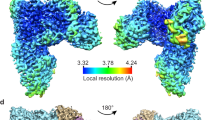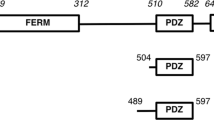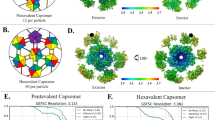Abstract
The oncoprotein E7 of human papilloma viruses (HPV) is involved in the pathogenesis and maintenance of human cervical cancers. The most prevalent HPV types found in cervix carcinomas are HPV16, 18 and 45. The structure of the E7 dimer from HPV45 (PDB 2F8B) was determined by nuclear magnetic resonance spectroscopy. Each monomer comprises an unfolded N-terminus and a well-structured C-terminal domain with a β1β2α1β3α2 topology representing a unique zinc-binding fold found only for E7. Dimerization occurs through the α1/α1′ helices and intermolecular β-sheet formation but excludes the zinc-binding sites. E7 is reported to interact with a number of cellular proteins (e.g. pRb, p21CIP1). Binding of a peptide derived from the C-terminus of p21CIP1 to the C-terminal domain of E7 was characterized by monitoring chemical shift perturbations of the amide groups of E7. This provides direct evidence that a shallow groove situated between α1 and β1 of the E7 C-terminal domain is interacting with the C-terminus of p21CIP1. Intriguingly, this binding site overlaps with the low-affinity binding site on E7 for the C-domain of pRb.
This is a preview of subscription content, access via your institution
Access options
Subscribe to this journal
Receive 50 print issues and online access
$259.00 per year
only $5.18 per issue
Buy this article
- Purchase on Springer Link
- Instant access to full article PDF
Prices may be subject to local taxes which are calculated during checkout




Similar content being viewed by others
References
Alonso LG, Garcia-Alai MM, Nadra AD, Lapena AN, Almeida FL, Gualfetti P et al. (2002). Biochemistry 41: 10510–10518.
Avvakumov N, Torchia J, Mymryk JS . (2003). Oncogene 22: 3833–3841.
Barbosa MS, Edmonds C, Fisher C, Schiller JT, Lowy DR, Vousden KH . (1990). EMBO J 9: 153–160.
Barbosa MS, Lowy DR, Schiller JT . (1989). J Virol 63: 1404–1407.
Bartels C, Xia T, Billeter M, Guntert P, Wuthrich K . (1995). J Biomol NMR 6: 1–10.
Binsted N, Strange RW, Hasnain SS . (1992). Biochemistry 31: 12117–12125.
Bischof O, Nacerddine K, Dejean A . (2005). Mol Cell Biol 25: 1013–1024.
Bosch FX, de Sanjose S . (2003). J Natl Cancer Inst Monogr 31: 3–13.
Braspenning J, Marchini A, Albarani V, Levy L, Ciccolini F, Cremonesi C et al. (1998). Oncogene 16: 1085–1089.
Brehm A, Nielsen SJ, Miska EA, McCance DJ, Reid JL, Bannister AJ et al. (1999). EMBO J 18: 2449–2458.
Brzovic PS, Rajagopal P, Hoyt DW, King MC, Klevit RE . (2001). Nat Struct Biol 8: 833–837.
Clements A, Johnston K, Mazzarelli JM, Ricciardi RP, Marmorstein R . (2000). Biochemistry 39: 16033–16045.
de Villiers EM, Fauquet C, Broker TR, Bernard HU, zur Hausen H . (2004). Virology 324: 17–27.
Dotto GP . (2000). Biochim Biophys Acta 1471: M43–M56.
Dyson HJ, Wright PE . (2005). Nat Rev Mol Cell Biol 6: 197–208.
Funk JO, Waga S, Harry JB, Espling E, Stillman B, Galloway DA . (1997). Genes Dev 11: 2090–2100.
Goodwin EC, DiMaio D . (2000). Proc Natl Acad Sci USA 97: 12513–12518.
Gorlach M, Wittekind M, Beckman RA, Mueller L, Dreyfuss G . (1992). EMBO J 11: 3289–3295.
Gulbis JM, Kelman Z, Hurwitz J, O’Donnell M, Kuriyan J . (1996). Cell 87: 297–306.
Guntert P, Billeter M, Ohlenschlager O, Brown LR, Wuthrich K . (1998). J Biomol NMR 12: 543–548.
Guntert P, Mumenthaler C, Wuthrich K . (1997). J Mol Biol 273: 283–298.
Helt AM, Funk JO, Galloway DA . (2002). J Virol 76: 10559–10568.
Herrmann T, Guntert P, Wuthrich K . (2002). J Mol Biol 319: 209–227.
Jones DL, Alani RM, Munger K . (1997). Genes Dev 11: 2101–2111.
Koradi R, Billeter M, Wuthrich K . (1996). J Mol Graph 14: 51–55.
Kriwacki RW, Hengst L, Tennant L, Reed SI, Wright PE . (1996). Proc Natl Acad Sci USA 93: 11504–11509.
Laskowski RA, Rullmannn JA, MacArthur MW, Kaptein R, Thornton JM . (1996). J Biomol NMR 8: 477–486.
Lee JO, Russo AA, Pavletich NP . (1998). Nature 391: 859–865.
Liu X, Clements A, Zhao K, Marmorstein R . (2006). J Biol Chem 281: 578–586.
Mannhardt B, Weinzimer SA, Wagner M, Fiedler M, Cohen P, Jansen-Durr P et al. (2000). Mol Cell Biol 20: 6483–6495.
McIntyre MC, Frattini MG, Grossman SR, Laimins LA . (1993). J Virol 67: 3142–3150.
Munger K, Baldwin A, Edwards KM, Hayakawa H, Nguyen CL, Owens M et al. (2004). J Virol 78: 11451–11460.
Munger K, Basile JR, Duensing S, Eichten A, Gonzalez SL, Grace M et al. (2001). Oncogene 20: 7888–7898.
Munger K, Phelps WC, Bubb V, Howley PM, Schlegel R . (1989). J Virol 63: 4417–4421.
Phelps WC, Munger K, Yee CL, Barnes JA, Howley PM . (1992). J Virol 66: 2418–2427.
Schlott B, Wohnert J, Icke C, Hartmann M, Ramachandran R, Guhrs KH et al. (2002). J Mol Biol 318: 533–546.
Singh M, Krajewski M, Mikolajka A, Holak TA . (2005). J Biol Chem 280: 37868–37876.
Villa LL . (1997). Adv Cancer Res 71: 321–341.
Vuister GW, Bax A . (1993). J Am Chem Soc 115: 7772–7777.
Xiao B, Spencer J, Clements A, Ali-Khan N, Mittnacht S, Broceno C et al. (2003). Proc Natl Acad Sci USA 100: 2363–2368.
zur Hausen H . (1996). Biochim Biophys Acta 1288: F55–F78.
Zwahlen C, Legault P, Vincent SJF, Greenblatt J, Konrat R, Kay LE . (1997). J Am Chem Soc 119: 6711–6721.
Zwerschke W, Jansen-Durr P . (2000). Adv Cancer Res 78: 1–29.
Acknowledgements
We thank M Stoldt, FZ Jülich, for the acquisition of a NOESY spectrum at 800 MHz, S Mensch and H Schwalbe, University Frankfurt, for providing the p21CIP1 peptide, J Wöhnert for critically reading the manuscript and the support from the EC Research Infrastructure Action (RII3/CT/2004/5060008). The Fritz Lipmann Institute is financially supported by the State of Thuringia and the Federal Government of Germany.
Author information
Authors and Affiliations
Corresponding author
Additional information
Supplementary Information accompanies the paper on the Oncogene website (http://www.nature.com/onc).
Supplementary information
Rights and permissions
About this article
Cite this article
Ohlenschläger, O., Seiboth, T., Zengerling, H. et al. Solution structure of the partially folded high-risk human papilloma virus 45 oncoprotein E7. Oncogene 25, 5953–5959 (2006). https://doi.org/10.1038/sj.onc.1209584
Received:
Revised:
Accepted:
Published:
Issue Date:
DOI: https://doi.org/10.1038/sj.onc.1209584
Keywords
This article is cited by
-
Novel computational and drug design strategies for inhibition of human papillomavirus-associated cervical cancer and DNA polymerase theta receptor by Apigenin derivatives
Scientific Reports (2023)
-
Structural dynamic studies on identification of EGCG analogues for the inhibition of Human Papillomavirus E7
Scientific Reports (2020)
-
The free energy landscape of the oncogene protein E7 of human papillomavirus type 16 reveals a complex interplay between ordered and disordered regions
Scientific Reports (2019)
-
Analysis of human papillomavirus E7 protein status in C-33A cervical cancer cells
Virus Genes (2015)
-
Structure and dynamics of a primordial catalytic fold generated by in vitro evolution
Nature Chemical Biology (2013)



